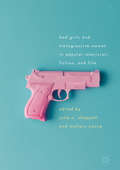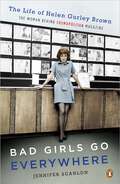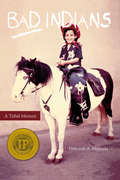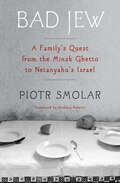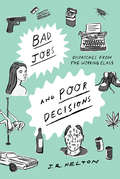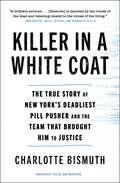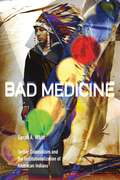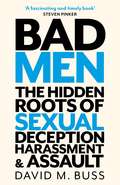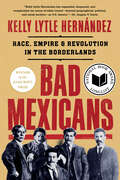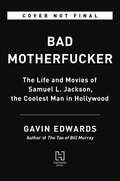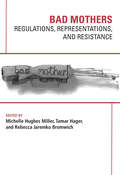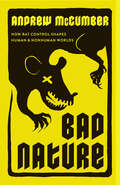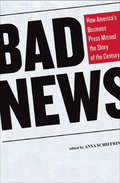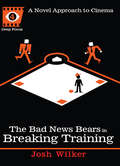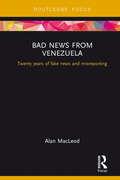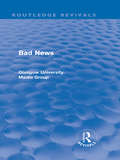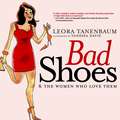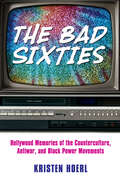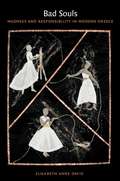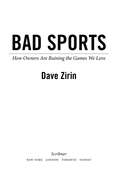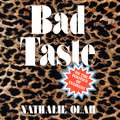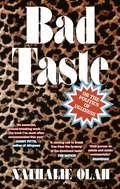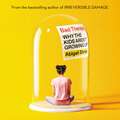- Table View
- List View
Bad Girls and Transgressive Women in Popular Television, Fiction, and Film
by Julie A. Chappell Mallory YoungThis edited volume interrogates the representation of transgressive women in television, popular fiction, and mainstream film from the mid-to-late twentieth and early twenty-first centuries. Each of essay concentrates on the perception of women, young and old, as "bad girls," those defying or transgressing the traditional social roles, attitudes, and pursuits defined as "appropriate" for women and girls. In presenting these treatments, this volume analyzes longstanding and more recent questions surrounding the role and importance of women who "just say no. " With examples across popular media and literature, what remains a constant among all of these bad girls despite their different media and personalities is the will to cross the boundaries of behavior deemed, by prevailing authorities, to be acceptable.
Bad Girls Go Everywhere: The Life of Helen Gurley Brown, the Woman Behind Cosmopolitan Magazine
by Jennifer ScanlonThe biography of the revolutionary magazine editor who created the &“Cosmo Girl&” before Sex and the City&’s Carrie Bradshaw was even bornAs the author of the iconic Sex and the Single Girl (1962) and the editor-in-chief of Cosmopolitan magazine for over three decades, Helen Gurley Brown (1922–2012) changed how women thought about sex, money, and their bodies in a way that resonates in our culture today. In Jennifer Scanlon's widely acclaimed biography, the award-winning scholar reveals Brown&’s incredible life story from her escape from her humble beginnings in the Ozarks to her eyebrow-raising exploits as a young woman in New York City, and her late-blooming career as the world's first "lipstick feminist." A mesmerizing tribute to a legend, Bad Girls Go Everywhere will appeal to everyone from Sex and the City and Mad Men fans to students of women's history and media studies.
Bad Indians: A Tribal Memoir
by Deborah MirandaThis beautiful and devastating book—part tribal history, part lyric and intimate memoir—should be required reading for anyone seeking to learn about California Indian history, past and present. <P><P>Deborah A. Miranda tells stories of her Ohlone Costanoan Esselen family as well as the experience of California Indians as a whole through oral histories, newspaper clippings, anthropological recordings, personal reflections, and poems. <P><P> The result is a work of literary art that is wise, angry, and playful all at once, a compilation that will break your heart and teach you to see the world anew.
Bad Jew: A Familys Quest from the Minsk Ghetto to Netanyahus Israel
by Piotr SmolarCombining memoir, history, and political essay, an acclaimed French journalist delves into his family&’s past in this searing, nuanced investigation of Jewish identity and what it means in the diaspora versus Israel today.What is a Jew? There are as many answers as there are Jewish people.Written four years ago, and now available in English with a new introduction, Bad Jew speaks intelligently to our current crises. A striking portrait of the identity fever that has overtaken the Israeli right, and a moving family saga, it follows three generations, three Jewish men, each involved in public life in his own personal way: Piotr Smolar&’s grandfather, a passionate Polish communist, who led the resistance in the Minsk ghetto during World War II; Smolar&’s father, who opposed the communist regime in Poland in 1968 and had to flee the country; and Smolar himself, confronted with the question of Jewish identity after becoming Le Monde&’s correspondent in Jerusalem.Deftly interweaving their stories of activism and migration, Smolar explores how tribalism harms democracy and asks difficult questions: when does loyalty turn into betrayal? What place is left for basic values and empathy? This important book has never been timelier.
Bad Jobs and Poor Decisions: Dispatches From The Working Class
by J. R. HeltonWeaving the brackish humor of Chuck Palahniuk’s Fight Club with the empathy of Barbara Ehrenreich’s Nickel and Dimed, J. R. Helton brings to life an obscured, all-too-often ignored slice of the American psyche in this unflinching memoir of blue-collar Texas. In the 1980s, somewhere in Austin, Helton was young, married, and jobless. After a few strung-out years trying to make it as a writer, he was caught in a cycle of drunken, coked-up nights, crashing on friends’ couches and looking for money in the morning. Succumbing to the daunting reality of what it means to support both himself and a troubled marriage, he became a housepainter. He sold pumpkins on the side of the road, delivered firewood, ran a crew of illegal immigrants hauling railroad ties across the empty plains of Kansas, and then he painted even more. Despair is transformed into resilience as Helton insightfully narrates his wayward years, enduring hateful employers and mind-numbing manual labor. Along the way, the people toiling beneath the saccharine veneer of wealth that was the Reagan years are brought to vivid life: the ambitious and the lazy, the potheads and the racists, as well as Vietnam vets too shaken to hold a paintbrush and deadbeat fathers straining to pay child support. With intoxicating, blasé-faire sentiment, Helton shows that everyone—from the beauties at the rodeo to the lowest laborers—is tethered by a common desire to just pay the bills and balm the loneliness. A raw and moving account, Bad Jobs and Poor Decisions captures a microcosm of left-behind America that straddles a dangerous line between ruin and redemption.
Bad Medicine: Catching New York's Deadliest Pill Pusher
by Charlotte Bismuth&“Charlotte Bismuth gives us a bold and cinematic true crime story about her work at the intersection of medicine and greed. Bad Medicine is a gripping memoir that toggles deftly between the personal and prosecutorial.&” —Beth Macy, New York Times bestselling author of Dopesick &“Bismuth has written a brilliant account of prosecuting a doctor who became a drug dealer in a white coat. She is haunted by the voices of the dead and listening closely to the voices of the living.&” —Nan Goldin, artist, activist, and founder of P.A.I.N. &“Bad Medicine is a taut exploration of America&’s deadly battle with opioid addiction—an unnerving and inspirational firecracker of a book.&” —Karen Abbott, New York Times bestselling author of The Ghosts of Eden Park For fans of Dopesick and Bad Blood, the shocking story of New York&’s most infamous pill-pushing doctor, written by the prosecutor who brought him down.In 2010, a brave whistleblower alerted the police to Dr. Stan Li&’s corrupt pain management clinic in Queens, New York. Li spent years supplying more than seventy patients a day with oxycodone and Xanax, trading prescriptions for cash. Emergency room doctors, psychiatrists, and desperate family members warned him that his patients were at risk of death but he would not stop. In Bad Medicine, former prosecutor Charlotte Bismuth meticulously recounts the jaw dropping details of this criminal case that would span four years, culminating in a landmark trial. As a new assistant district attorney and single mother, Bismuth worked tirelessly with her team to bring Dr. Li to justice. Bad Medicine is a chilling story of corruption and greed and an important look at the role individual doctors play in America&’s opioid epidemic.
Bad Medicine: Settler Colonialism and the Institutionalization of American Indians
by Sarah A. WhittIn Bad Medicine, Sarah A. Whitt exposes how Native American boarding schools and other settler institutions like asylums, factories, and hospitals during the late nineteenth and early twentieth centuries worked together as a part of an interconnected system of settler domination. In so doing, Whitt centers the experiences of Indigenous youth and adults alike at the Carlisle Indian School, Canton Asylum for Insane Indians, Ford Motor Company Factory, House of the Good Shepherd, and other Progressive Era facilities. She demonstrates that in the administration of these institutions, which involved moving Indigenous people from one location to another, everyday white Americans became deputized as agents of the settler order. Bringing together Native American history, settler colonial studies, and the history of medicine, Whitt breaks new ground by showing how the confinement of Indigenous people across interlocking institutional sites helped concretize networks of white racial power—a regime that Native nations and communities continue to negotiate and actively resist today.
Bad Men: The Hidden Roots of Sexual Deception, Harassment and Assault
by David BussSexual conflict permeates ancient religions, from injunctions about thy neighbor's wife to the sexual obligations of marriage. It is etched in written laws that dictate who can and cannot have sex with whom. Its manifestations shape our sexual morality, evoking approving accolades or contemptuous condemnation. It produces sexual double standards that flourish even in the most sexually egalitarian cultures on earth. And although every person alive struggles with sexual conflict, most of us see only the tip of the iceberg: dating deception, a politician's unsavory grab, the slow crumbling of a once-happy marriage, a romantic breakup that turns nasty.Bad Men shows that this "battle of the sexes" is deeper and far more pervasive than anyone has recognized, revealing the hidden roots of sexual conflict -- roots that originated over deep evolutionary time -- which characterise our sexual psychology. Providing novel insights into our minds and behaviours, Bad Men presents a unifying new theory of sexual conflict and offers practical advice for men and women seeking to avoid it.
Bad Mexicans: Race, Empire, and Revolution in the Borderlands
by Kelly Lytle HernándezWinner of the Bancroft Prize • One of The New Yorker’s Best Books of 2022 • A Kirkus Best World History Book of 2022 One of Smithsonian's 10 Best History Books of 2022 • Longlisted for the 2022 National Book Award for Nonfiction • Shortlisted for the PEN/John Kenneth Galbraith Award for Nonfiction • Shortlisted for the National Book Critics Circle Award for Nonfiction • Shortlisted for the Mark Lynton History prize • Longlisted for the Cundill History Prize “Rebel historian” Kelly Lytle Hernández reframes our understanding of U.S. history in this groundbreaking narrative of revolution in the borderlands. Bad Mexicans tells the dramatic story of the magonistas, the migrant rebels who sparked the 1910 Mexican Revolution from the United States. Led by a brilliant but ill-tempered radical named Ricardo Flores Magón, the magonistas were a motley band of journalists, miners, migrant workers, and more, who organized thousands of Mexican workers—and American dissidents—to their cause. Determined to oust Mexico’s dictator, Porfirio Díaz, who encouraged the plunder of his country by U.S. imperialists such as Guggenheim and Rockefeller, the rebels had to outrun and outsmart the swarm of U. S. authorities vested in protecting the Diaz regime. The U.S. Departments of War, State, Treasury, and Justice as well as police, sheriffs, and spies, hunted the magonistas across the country. Capturing Ricardo Flores Magón was one of the FBI’s first cases. But the magonistas persevered. They lived in hiding, wrote in secret code, and launched armed raids into Mexico until they ignited the world’s first social revolution of the twentieth century. Taking readers to the frontlines of the magonista uprising and the counterinsurgency campaign that failed to stop them, Kelly Lytle Hernández puts the magonista revolt at the heart of U.S. history. Long ignored by textbooks, the magonistas threatened to undo the rise of Anglo-American power, on both sides of the border, and inspired a revolution that gave birth to the Mexican-American population, making the magonistas’ story integral to modern American life.
Bad Motherfucker: The Life and Movies of Samuel L. Jackson, the Coolest Man in Hollywood
by Gavin EdwardsA fascinating exploration and celebration of the life and work of the coolest man in Hollywood, Samuel L. Jackson—from his star-making turns in the films of Spike Lee and Quentin Tarantino to his ubiquitous roles in the Star Wars and Marvel franchises, not to mention the cult favorite Snakes on a Plane.Samuel L. Jackson&’s embodiment of cool isn&’t just inspirational—it&’s important. Bad Motherfucker lays out how his attitude intersects with his identity as a Black man, why being cool matters in the modern world, and how Jackson can guide us through the current cultural moment in which everyone is losing their cool. Edwards details Jackson&’s fascinating personal history, from stuttering bookworm to gunrunning revolutionary to freebasing addict to A-list movie star.Drawing on original reporting and interviews, the book explores not only the major events of Jackson&’s life but also his obsessions: golf, kung fu movies, profanity. Bad Motherfuckerfeatures a delectable filmography of Jackson&’s movies—140 and counting!—and also includes new movie posters for many of Jackson&’s greatest roles, reimagined by dozens of gifted artists and designers. The book provides a must-read road map through the vast territory of his on-screen career and more: a vivid portrait of Samuel L. Jackson&’s essential self, as well as practical instructions, by example, for how to live and work and be.
Bad Mothers: Regulations, Representations, And Resistance
by Hughes Michelle MillerWhile the image or construct of the "good mother" has been the focus of many research projects, the "bad mother," as a discursive construct, and also mothers who do "bad" things as complicated, agentic social actors, have been quite neglected, despite the prevalence of the image of the bad mother across late modern societies. The few researchers who address this powerful social image point out that bad mothers are culturally identified by what they do, yet they are also socially recognized by who they are. Mothers become potentially bad when they behave or express opinions that diverge from, or challenge, social or gender norms, or when they deviate from mainstream, white, middle class, heterosexual, nondisabled normativity. When suspected of being bad mothers, women are surveilled, and may be disciplined, punished or otherwise excluded, by various official agents (i.e. legal, medical and welfare institutions), as well as by their relatives, friends and communities. Too often, women are judged and punished without clear evidence that they are neglecting or abusing their children. Frequently they are blamed for the marginal sociocultural context in which they are mothering. This anthology presents empirical, theoretical and creative works that address the construct of the bad mother and the lived realities of mothers labeled as bad. Throughout the volume, the editors consider voices and acts of resistance to bad mother constructions, demonstrating that mothers, across time and across domains, have individually and collectively taken a stand against this destructive label.
Bad Nature: How Rat Control Shapes Human and Nonhuman Worlds
by Andrew McCumberOffers insights into the social and cultural implications of humans’ relationships with rats and the natural world. Apart from the occasional pet owner who has rats, most people regard rats as disease-carrying nocturnal pests, scurrying around dumpsters and dragging slices of pizza through New York City subways. Since rats are seemingly omnipresent in human life, why do we harbor such negative feelings about them, and why are they among the creatures most frequently targeted for systematic extermination? In Bad Nature, sociologist Andrew McCumber draws out the cultural underpinnings of rat extermination across three countries and two continents. Drawing from ethnographic, interview, and textual data from the frigid prairie of Alberta, Canada; the heart of downtown Los Angeles, California; and the iconic Galápagos Islands of Ecuador, McCumber studies how humans have sought to suppress and exterminate rat populations in a variety of environmental, social, and political situations. He shows how, in these disparate locations, rat control is a social practice that draws and clarifies the spatial and symbolic boundaries between “good” and “bad” forms of nature. Rats are near the bottom of a symbolic hierarchy of species that places human life at the top, companion animals and majestic wildlife just below them, and the “invasive species” that call for systematic extermination at the very bottom. This hierarchy of living things that places rats at the bottom, McCumber argues, mirrors human systems of social inequalities and power dynamics. Both original and engaging, Bad Nature urges readers to consider, when charting a just and sustainable future, where will the rats be placed in the worlds we envision?
Bad News: How America's Business Press Missed the Story of the Century
by Anya SchiffrinLeading scholars and journalists assess the media&’s failure to see the financial crisis coming. &“A sort of All the President&’s Men for our time&” (Kirkus Reviews). Where was the business press in the weeks and months leading up to the deepest financial crisis since the Great Depression? As our economy unraveled, journalists struggled to keep up with the story of the century, grappling with an alphabet soup of derivatives, backroom deals, and toxic financial instruments. But many fault the media itself for having helped to create the bubble in the first place. Did the press fail its mandate as an engine of truth by buying into the hubris and exuberance of the preceding decades? Bad News is a foundational text for navigating a controversy that will be studied for years to come. With contributions from leading journalists and academics—including Nobel Laureate Joseph Stiglitz, International Consortium of Investigative Journalists&’ senior editor Dean Starkman, and the New York Times&’ European economics correspondent Peter S. Goodman—this collection presents a complex debate in a highly accessible format for anyone from curious readers and scholars to journalists themselves. And ultimately, the questions it raises illuminate the heated debate about the media&’s role as guardians of our democracy. &“There are three 24-hour financial networks. All their slogans are like, &‘We know what&’s going on on Wall Street.&’ But then you turn it on during the crisis, and they&’re like, &‘We don&’t know what&’s going on.&’ It&’d be like turning on the Weather Channel in a hurricane and they&’re just doing this: [shuddering] &‘Why am I wet?! What&’s happening to me? And it&’s so windy!&’&” —Jon Stewart &“Thorough, hard-hitting, and admirably balanced.&” —James Ledbetter, editor in charge, Reuters
The Bad News Bears in Breaking Training: A Novel Approach to Cinema (Deep Focus #4)
by Josh Wilker Sean HoweIn 1977, The Bad News Bears in Breaking Training had a moment in the sun. A glowing junk sculpture of American genres-sports flick, coming-of-age story, family melodrama, after-school special, road narrative-the film cashed in on the previous year's success of its predecessor, The Bad News Bears. Arguing against the sequel's dismissal as a cultural afterthought, Josh Wilker lovingly rescues from the oblivion of cinema history a quintessential expression of American resilience and joy.Rushed into theaters by Paramount when the beleaguered film industry was suffering from "acute sequelitis," the (undeniably flawed) movie miraculously transcended its limitations to become a gathering point for heroic imagery drawn from American mythology. Considered in context, the film's unreasonable optimism, rooted in its characters' sincere desire to keep playing, is a powerful response to the political, economic, and social stresses of the late 1970s.To Wilker's surprise, despite repeated viewings, The Bad News Bears in Breaking Training continues to move him. Its huge heart makes it not only the ultimate fantasy of the baseball-obsessed American boy, but a memorable iteration of that barbed vision of pure sunshine itself, the American dream.
Bad News from Venezuela: Twenty years of fake news and misreporting (Routledge Focus on Communication and Society)
by Alan MacleodSince the election of President Hugo Chavez in 1998, Venezuela has become an important news item. Western coverage is shaped by the cultural milieu of its journalists, with news written from New York or London by non-specialists or by those staying inside wealthy guarded enclaves in an intensely segregated Caracas. Journalists mainly work with English-speaking elites and have little contact with the poor majority. Therefore, they reproduce ideas largely attuned to a Western, neoliberal understanding of Venezuela. Through extensive analysis of media coverage from Chavez’s election to the present day, as well as detailed interviews with journalists and academics covering the country, Bad News from Venezuela highlights the factors contributing to reportage in Venezuela and why those factors exist in the first place. From this examination of a single Latin American country, the book furthers the discussion of contemporary media in the West, and how, with the rise of ‘fake news’, their operations have a significant impact on the wider representation of global affairs. Bad News from Venezuela is comprehensive and enlightening for undergraduate students and research academics in media and Latin American studies.
Bad News (Routledge Revivals)
by Peter Beharrell Howard Davis John Eldridge John Hewitt Jean Hart Gregg Philo Paul Walton Brian WinstonIt is a commonly held belief that television news in Britain, on whatever channel, is more objective, more trustworthy, more neutral than press reporting. The illusion is exploded in this controversial study by the Glasgow University Media Group, originally published in 1976. The authors undertook an exhaustive monitoring of all television broadcasts over 6 months, from January to June 1975, with particular focus upon industrial news broadcasts, the TUC, strikes and industrial action, business and economic affairs. Their analysis showed how television news favours certain individuals by giving them more time and status. But their findings did not merely deny the neutrality of the news, they gave a new insight into the picture of industrial society that TV news constructs.
Bad or, The Dumbing of America
by Paul FussellA curmudgeonly look at American culture in the 80s/90s, intent on demonstrating how monstrously bad much of it was.
Bad Shoes & The Women Who Love Them
by Leora Tanenbaum Vanessa DavisBad Shoes & the Women Who Love Them is a lighthearted wake-up call to women to make informed decisions when buying and wearing fashionable shoes. Arming the reader with essential facts, citing medical literature as well as leading podiatric surgeons and orthopedists, Tanenbaum covers the history of high heels, Chinese foot binding, the controversy over cosmetic surgery of the foot, and what Freud had to say about women's shoes and sex.Illustrated by artist Vanessa Davis throughout, Bad Shoes & the Women Who Love Them also includes hilarious anecdotes from women who love shoes. And yes--it is possible to make smart footwear decisions without sacrificing style! Tanenbaum shows you how.
The Bad Sixties: Hollywood Memories of the Counterculture, Antiwar, and Black Power Movements (Race, Rhetoric, and Media Series)
by Kristen HoerlWinner of the 2018 Book Award from the American Studies Division of the National Communication AssociationOngoing interest in the turmoil of the 1960s clearly demonstrates how these social conflicts continue to affect contemporary politics. In The Bad Sixties: Hollywood Memories of the Counterculture, Antiwar, and Black Power Movements, Kristen Hoerl focuses on fictionalized portrayals of 1960s activism in popular television and film. Hoerl shows how Hollywood has perpetuated politics deploring the detrimental consequences of the 1960s on traditional American values. During the decade, people collectively raised fundamental questions about the limits of democracy under capitalism. But Hollywood has proved dismissive, if not adversarial, to the role of dissent in fostering progressive social change.Film and television are salient resources of shared understanding for audiences born after the 1960s because movies and television programs are the most accessible visual medium for observing the decade's social movements. Hoerl indicates that a variety of television programs, such as Family Ties, The Wonder Years, and Law and Order, along with Hollywood films, including Forrest Gump, have reinforced images of the "bad sixties." These stories portray a period in which urban riots, antiwar protests, sexual experimentation, drug abuse, and feminism led to national division and moral decay. According to Hoerl, these messages supply distorted civics lessons about what we should value and how we might legitimately participate in our democracy.These warped messages contribute to "selective amnesia," a term that stresses how popular media renders radical ideas and political projects null or nonexistent. Selective amnesia removes the spectacular events and figures that define the late-1960s from their motives and context, flattening their meaning into reductive stereotypes. Despite popular television and film, Hoerl explains, memory of 1960s activism still offers a potent resource for imagining how we can strive collectively to achieve social justice and equality.
Bad Souls: Madness and Responsibility in Modern Greece
by Elizabeth Anne DavisBad Souls is an ethnographic study of responsibility among psychiatric patients and their caregivers in Thrace, the northeastern borderland of Greece. Elizabeth Anne Davis examines responsibility in this rural region through the lens of national psychiatric reform, a process designed to shift treatment from custodial hospitals to outpatient settings. Challenged to help care for themselves, patients struggled to function in communities that often seemed as much sources of mental pathology as sites of refuge. Davis documents these patients' singular experience of community, and their ambivalent aspirations to health, as they grappled with new forms of autonomy and dependency introduced by psychiatric reform. Planned, funded, and overseen largely by the European Union, this "democratic experiment," one of many reforms adopted by Greece since its accession to the EU in the early 1980s, has led Greek citizens to question the state and its administration of human rights, social welfare, and education. Exploring the therapeutic dynamics of diagnosis, persuasion, healing, and failure in Greek psychiatry, Davis traces the terrains of truth, culture, and freedom that emerge from this questioning of the state at the borders of Europe.
Bad Sports
by Dave ZirinA THOUGHT-PROVOKING LOOK AT THE BIG BUSINESS AND IMMORAL PRACTICES BEHIND PROFESSIONAL SPORTS BY ACCLAIMED SPORTSWRITER DAVE ZIRIN, HAILED AS THE "CONSCIENCE OF AMERICAN SPORTSWRITING" (THE WASHINGTON POST )The fastest-growing sector of today's sports audience is the alienated fan. Complaints abound: from inflated ticket prices, $6 hot dogs, and $9 beers to owners endlessly demanding new multimillion-dollar stadiums funded by public tax dollars. Those sitting in the owners' boxes are increasingly placing profit over players' performances and fan loyalty. Bad Sports cuts through the hype and bombast to zero in on tales of abusive, dictatorial owners who move their teams thousands of miles away from their fan base, use their stadiums as religious and political platforms, or hold communities ransom for millions of dollars of taxpayer money to fund their gargantuan stadiums.As the multibillion-dollar sports-industrial complex continues to lumber along, Dave Zirin is the voice in the wilderness, speaking out for the common fan with a tough, passionate, and intelligent voice that will remind readers that there is more to sportswriting than glowing athlete profiles.
Bad Taste: Or the Politics of Ugliness
by Nathalie OlahA bold and original exploration from a renowned radical thinker, exploring the consequences of our obsession with image and taste.This is not a taste, nor an anti-taste, manual. This is an interrogation of the importance we place on seemingly objective ideas of taste in a culture that is saturated by imagery, and the dangerous impact this has on our identities, communities and politics. This book is dedicated to understanding the industries of taste. From the food we eat to the way we spend our free time, Olah exposes the shallow waters of 'good' and 'bad' taste and the rigid hierarchies that uphold this age-old dichotomy. -How did minimalism become a virtue, and who can afford to do it justice?When did blue-collar jackets become a fashion item?Who stands to gain from the distinction made between beauty, and sex?- Bold, original and provocative, Bad Taste is a revelatory exploration of the intersection between consumerism, class, desire and power, and a rousing call-to-arms to break free from the restrictive ways we see those around us.(P) 2023 Little Brown Book Group Limited for and on behalf of Dialogue Books
Bad Taste: Or the Politics of Ugliness
by Nathalie OlahA timely critique of consumer culture which captures this image-obsessed moment in history, perfect for fans of Zadie Smith's Feel Free and Jia Tolentino's Trick Mirror.This book is not a taste, nor an anti-taste, manual. This is an interrogation of the importance we place on seemingly objective ideas of taste in a culture that is saturated by imagery, and the dangerous impact this has on our identities, communities and politics. This book is dedicated to understanding the industries of taste. From the food we eat to the way we spend our free time, Olah exposes the shallow waters of 'good' and 'bad' taste and the rigid hierarchies that uphold this age-old dichotomy. -How did minimalism become a virtue, and who can afford to do it justice?When did blue-collar jackets become a fashion item?Who stands to gain from the distinction made between beauty, and sex?- Bold, original and provocative, Bad Taste is a revelatory exploration of the intersection between consumerism, class, desire and power, and a rousing call-to-arms to break free from the restrictive ways we see those around us.
Bad Therapy: Why the Kids Aren't Growing Up
by Abigail ShrierIn virtually every way that can be measured, Gen Z's mental health is worse than that of previous generations. Youth suicide rates are climbing, antidepressant prescriptions for children are common, and the proliferation of mental health diagnoses has not stopped the trend. What has gone wrong with our youth?In Bad Therapy, bestselling investigative journalist Abigail Shrier argues that the problem isn't the kids - it's the mental health experts. Mental health care can be lifesaving when properly applied, but that is not what's happening. Instead, children experiencing the normal pangs of adolescence and their anxious parents are seeking answers from therapists, who are only too happy to explore what might be wrong - and to make money doing so. No industry seems to turn away from the possibility of exponential growth, and our mental health industry is no exception. It asks children, again and again: How do you feel? Are you sure? By treating the well, it is making them sick, feeding normal kids with normal problems into the mental healthcare pipeline. It is minting patients faster than it can cure them.Drawing on extensive research and interviews with doctors, parents, therapists and young people, Shrier enumerates the dangerous side effects of unnecessary or poorly executed mental health care. With clear eyes and compassion, she examines ways worried parents who think they must indulge their child's every feeling make matters worse, and she offers liberating advice for raising emotionally resilient and independent children.Packed with relatable stories, devastating insights, and common-sense conclusions, Bad Therapy is a must-read for anyone concerned about protecting the next generation.
The Bad Wife Handbook (Wesleyan Poetry Series)
by Rachel ZuckerRachel Zucker's third book of poems is a darkly comic collection that looks unsparingly at the difficulties and compromises of married life. Formally innovative and blazingly direct, The Bad Wife Handbook cross-examines marriage, motherhood, monogamy, and writing itself. Rachel Zucker's upending of grammatical and syntactic expectations lends these poems an urgent richness and aesthetic complexity that mirrors the puzzles of real life. Candid, subversive, and genuinely moving, The Bad Wife Handbook is an important portrait of contemporary marriage and the writing life, of emotional connection and disconnection, of togetherness and aloneness.
